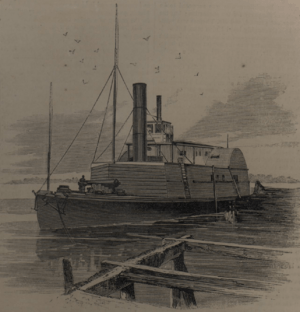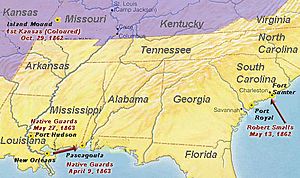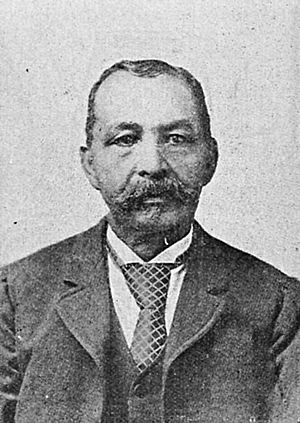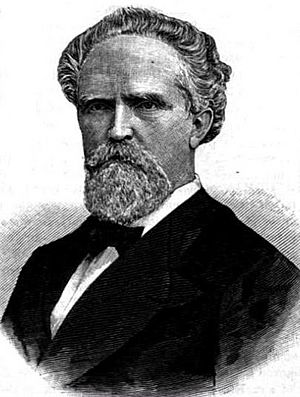Robert Smalls facts for kids
Quick facts for kids
Robert Smalls
|
|
|---|---|
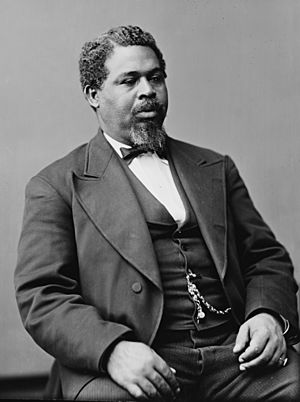 |
|
| Member of the U.S. House of Representatives from South Carolina's 7th district |
|
| In office March 18, 1884 – March 3, 1887 |
|
| Preceded by | Edmund W. M. Mackey |
| Succeeded by | William Elliott |
| Member of the U.S. House of Representatives from South Carolina's 5th district |
|
| In office July 19, 1882 – March 3, 1883 |
|
| Preceded by | George D. Tillman |
| Succeeded by | John J. Hemphill |
| In office March 4, 1875 – March 3, 1879 |
|
| Preceded by | Constituency reestablished |
| Succeeded by | George D. Tillman |
| Member of the South Carolina Senate from Beaufort County |
|
| In office November 22, 1870 – March 4, 1875 |
|
| Preceded by | Jonathan Jasper Wright |
| Succeeded by | Samuel Greene |
| Member of the South Carolina House of Representatives from Beaufort County |
|
| In office November 24, 1868 – November 22, 1870 |
|
| Personal details | |
| Born | April 5, 1839 Beaufort, South Carolina, U.S. |
| Died | February 23, 1915 (aged 75) Beaufort, South Carolina, U.S. |
| Political party | Republican |
| Spouses |
Hannah Jones
(m. 1856; died 1883)Annie Wigg
(m. 1890; died 1895) |
| Children | 4 |
| Military service | |
| Allegiance | United States |
| Branch/service | United States Navy United States |
| Years of service | 1862–1868 |
| Rank | None (Civilian pilot and armed transport captain) |
| Battles/wars | Blockade of Charleston • Battle of Simmon's Bluff • Second Battle of Pocotaligo • Second Battle of Fort Sumter Sherman's March to the Sea |
Robert Smalls (April 5, 1839 – February 23, 1915) was an amazing American hero. He was a politician, publisher, businessman, and ship pilot. Born into slavery in Beaufort, South Carolina, he bravely freed himself, his crew, and their families during the American Civil War.
He did this by taking control of a Confederate transport ship, the CSS Planter, in Charleston harbor on May 13, 1862. He then sailed it from Confederate waters to the U.S. blockade. His actions helped convince President Abraham Lincoln to allow African-American soldiers to join the Union Army.
After the war, Robert Smalls became a politician. He was elected as a Republican to the South Carolina Legislature and the United States House of Representatives. He helped create South Carolina's first free and required public school system. He also founded the Republican Party of South Carolina.
Contents
Early Life and Work
Robert Smalls was born in 1839. His mother, Lydia Polite, was enslaved by Henry McKee. Robert grew up in Beaufort, South Carolina, influenced by the Gullah culture. His mother worked as a servant. She wanted Robert to understand the hard lives of enslaved field workers.
When he was 12, Robert's master sent him to Charleston. He worked as a laborer, earning a small wage. He first worked in a hotel, then became a lamplighter. As a teenager, he loved the sea. He found work on the docks.
Smalls worked as a longshoreman, a rigger, and a sail maker. He eventually became a wheelman, like a helmsman. Enslaved people were not allowed the title of helmsman. Because of his work, he knew a lot about Charleston Harbor.
At 17, Smalls married Hannah Jones in Charleston on December 24, 1856. She was also enslaved and had two daughters. Their first child, Elizabeth Lydia Smalls, was born in 1858. They later had a son, Robert Jr., who died young. Robert wanted to buy his family's freedom. The price was $800, but he had only saved $100.
Robert Smalls During the Civil War
The American Civil War began in April 1861. Robert Smalls was assigned to steer the CSS Planter. This was a Confederate military transport ship. Its job was to survey waterways, lay mines, and deliver supplies. Smalls piloted the Planter all around Charleston harbor and nearby rivers. He could see the Union blockade ships seven miles away.
Smalls was trusted by the ship's crew and owners. In April 1862, he began planning an escape. He talked about it with most of the enslaved crew members.
The Daring Escape to Freedom
On May 12, 1862, the Planter picked up four large guns and ammunition. That evening, the ship was docked in Charleston. Its three white officers left to spend the night ashore. This was their usual custom. Smalls and the crew stayed on board. Smalls asked if the crews’ families could visit, and the captain agreed. When the families arrived, the men told them the escape plan.
The women and children were surprised. Hannah, Smalls' wife, told him, "It is a risk, dear, but you and I, and our little ones must be free. I will go, for where you die, I will die." The other women were scared at first but later happy for the chance at freedom.
Around 3 a.m. on May 13, Smalls and seven other enslaved crewmen began their escape. Smalls put on the captain's uniform and a straw hat. He sailed the Planter to another wharf to pick up his wife, children, and the families of other crewmen.
Smalls guided the ship past five Confederate forts. He gave the correct signals at each checkpoint. He copied the captain's manners and hat to fool the Confederate guards. The Planter sailed past Fort Sumter around 4:30 a.m.
As they neared Fort Sumter, everyone was very nervous. Smalls steered the ship along its normal path, slowly. When the fort flashed a challenge signal, Smalls gave the correct hand signs. There was a long pause, and Smalls feared cannon fire. Finally, the fort signaled that all was well, and the Planter sailed out of the harbor.
The alarm was only raised after the ship was far away. Smalls headed straight for the Union Navy fleet. He replaced the Confederate flags with a white bed sheet brought by his wife. A Union ship, the USS Onward, was about to fire. But a crewman spotted the white flag as the sun rose.
A witness described the scene: "As she neared us, we looked in vain for the face of a white man. When they discovered that we would not fire on them, there was a rush of contrabands out on her deck, some dancing, some singing, whistling, jumping... As the steamer came near... one of the Colored men stepped forward, and taking off his hat, shouted, 'Good morning, sir! I've brought you some of the old United States guns, sir!' That man was Robert Smalls."
The Onward's captain boarded the Planter. Smalls asked for a United States flag to display. He surrendered the Planter and its cargo to the United States Navy. Smalls' escape plan had worked!
The Planter carried four artillery pieces and ammunition. Most importantly, it had the captain's code book with Confederate signals. It also had a map of the mines in Charleston's harbor. Smalls' knowledge of the waterways and military setups was very valuable. Union officers learned from Smalls that only a few thousand troops were left to protect the area. This allowed Union forces to capture Coles Island without a fight.
Robert Smalls, just 23, became a hero in the North. Newspapers reported his brave actions. The U.S. Congress gave Smalls and his crew prize money for the Planter. Smalls' share was $1,500.
Smalls was invited to New York to help raise money for formerly enslaved people. He also went to Washington, D.C., in August 1862. He wanted to convince President Lincoln to allow Black men to fight for the Union. Soon after, an order was signed allowing up to 5,000 African Americans to join the Union forces.
Smalls worked as a civilian pilot for the Navy. He was present at 17 major battles. The Planter was valuable for its shallow design. Smalls helped find and remove mines that he had helped lay while enslaved. He also helped with the blockade between Charleston and Beaufort.
In April 1863, Smalls piloted the ironclad USS Keokuk. He took part in an attack on Fort Sumter. The Keokuk was badly damaged and sank the next morning. Smalls and most of the crew moved to another ship.
In December 1863, Smalls was piloting the Planter when Confederate forces attacked. The white captain fled. Smalls refused to surrender. He feared the Black crewmen would be killed. Smalls took command of the ship and piloted it to safety. For this, he was promoted to acting captain of the Planter.
In 1864, Smalls went to Philadelphia for ship repairs. There, he supported the Port Royal Experiment. This effort raised money for the education of formerly enslaved people. Smalls learned to read and write in Philadelphia.
While in Philadelphia, Smalls was ordered to give his seat to a white passenger on a streetcar. He refused to ride on the open platform and left the car. This incident helped lead to a law in Pennsylvania in 1867 that integrated public transportation.
In December 1864, Smalls and the Planter supported William T. Sherman's army in Savannah, Georgia. In April 1865, Smalls returned to Charleston harbor for the flag-raising ceremony at Fort Sumter. He was discharged from service in June 1865. He continued to pilot the Planter, delivering food and supplies to freed people.
Life After the Civil War
After the war, Robert Smalls returned to Beaufort. He bought his former master's house. His mother lived with him. He even allowed his former master's elderly wife to live in her old home before she died. Smalls spent nine months learning to read and write. He also bought a building to use as a school for African-American children.
Business and Community Work
In 1866, Smalls started a business in Beaufort with Richard Howell Gleaves. They opened a store for freedmen. Smalls also invested in the economic growth of the Charleston-Beaufort area. In 1870, he helped form the Enterprise Railroad. This was a horse-drawn railway that carried goods and passengers. Most of the railroad's directors were African American. Smalls also owned and helped publish a Black-owned newspaper, the Beaufort Southern Standard.
Robert Smalls' Political Career
Smalls' fame from the war and his ability to speak the Gullah dialect helped him in politics.
Political Beliefs
Smalls was a strong Republican. This party was powerful in the North and passed laws to protect African Americans. The Democrats, strong in the South, often opposed these laws. Smalls believed the Republican Party had freed four million enslaved people. He urged Black Americans to vote Republican.
State Politics
In 1868, Smalls was a delegate at the South Carolina Constitutional Convention. He worked to make free, required schooling available to all children in South Carolina. He also attended several Republican National Conventions.
In 1868, Smalls was elected to the South Carolina House of Representatives. He helped pass the Homestead Act and a Civil Rights bill. In 1870, he was elected to the South Carolina Senate. He was known as a good speaker and debater. He served on the Finance Committee.
He was promoted to brigadier-general of the South Carolina Militia. He held this position until 1877, when Democrats took control of the state government.
National Politics
In 1874, Smalls was elected to the United States House of Representatives. He served two terms from 1875 to 1879. He also represented South Carolina's 5th congressional district from 1882 to 1883. The state changed district boundaries, but Smalls was elected from the new 7th district and served from 1884 to 1887.
In Congress, he supported laws for racial integration. He also advised Black South Carolinians not to leave the South. He was the last Republican elected from the 5th district until 2010.
After the Compromise of 1877, U.S. troops left the South. Southern Democrats used violence and election fraud to regain power. Smalls was accused of taking a bribe. He was pardoned as part of a deal where charges against Democrats for election fraud were also dropped.
He lost elections in 1878 and 1880. But he successfully challenged the 1880 result and got his seat back in 1882. In 1890, President Benjamin Harrison appointed him collector of the Port of Beaufort. He held this job until 1913.
Smalls was a key Black delegate at the 1895 South Carolina constitutional convention. He strongly opposed the new constitution. It aimed to stop Black citizens from voting. He and five other Black politicians wrote an article to expose this unfair plan. However, the new constitution was adopted. This led to African Americans being excluded from politics for many decades.
In his later years, Smalls suffered from diabetes. He passed away on February 23, 1915, at age 75. He was buried in Beaufort. His monument has a famous quote: "My race needs no special defense, for the past history of them in this country proves them to be the equal of any people anywhere. All they need is an equal chance in the battle of life."
Honors and Legacy
- Fort Robert Smalls was named in his honor in 1863.
- The Robert Smalls House in Beaufort, South Carolina, is a National Historic Landmark.
- A monument and statue honor him at Tabernacle Baptist Church in Beaufort.
- The Robert Smalls School in Cheraw, South Carolina, is named for him.
- The Robert Smalls International Academy in Beaufort County, South Carolina, is named for him.
- During World War II, Camp Robert Smalls trained Black sailors.
- The Verdier House museum in Beaufort has an exhibit about Robert Smalls.
- In 2004, the U.S. Army named a ship after him, the USAV Major General Robert Smalls. It was the first Army ship named after an African American.
- Charleston held ceremonies in 2012 to mark 150 years since his escape on the Planter.
- Robert Smalls Parkway is a section of South Carolina Highway 170 leading into Beaufort.
- A statue of Robert Smalls is in the US National Museum of African American History and Culture.
See also
 In Spanish: Robert Smalls para niños
In Spanish: Robert Smalls para niños


